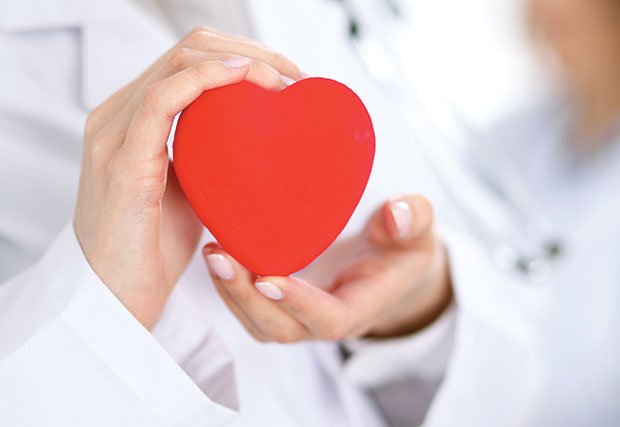Mark Swartz is the first patient at GW Hospital to receive a left ventricular assist device (LVAD), a mechanical pump that keeps his heart functioning while he awaits a heart transplant.
 Mark’s medical journey began in September 2017, when he had a heart attack at the gym. Paramedics rushed him to GW Hospital’s emergency room, where he was treated by the hospital’s emergency team, including Jonathan S. Reiner, MD, director of the cardiac catheterization laboratory. “Dr. Reiner saved my life that day,” Mark says.
Mark’s medical journey began in September 2017, when he had a heart attack at the gym. Paramedics rushed him to GW Hospital’s emergency room, where he was treated by the hospital’s emergency team, including Jonathan S. Reiner, MD, director of the cardiac catheterization laboratory. “Dr. Reiner saved my life that day,” Mark says.
The next big step was recovery. “I thought in a few weeks or months, I would go back to normal,” Mark recalls, but problems like shortness of breath were impairing his daily life. “I just wasn’t getting better,” he says.
For some patients like Mark, damage from a heart attack can lead to heart failure, which occurs when the heart isn’t strong enough to pump blood efficiently through the body. For specialized care to help treat this medical issue, Dr. Reiner introduced Mark to Gurusher Panjrath, MD, director of the Heart Failure and Mechanical Circulatory Support Program at GW Hospital.
Together, Dr. Panjrath and Mark discussed goals and treatment options. They decided that the best path forward was to pursue the LVAD implant as a “bridge” to a heart transplant, and Mark underwent an implant procedure performed by VAD surgeons Anthony Rongione, MD, surgical director for the VAD program, and Elizabeth Pocock, MD. While Mark waits for a donor, the mechanical pump assists his heart, so that he can be more active and enjoy a better quality of life. People who are bridged with a heart pump tend to do better with transplant surgery, Dr. Panjrath says.
Mark does not know when a donor heart might become available, but he is hopeful and remains focused on getting stronger. Adapting to life with his LVAD implant is an adjustment, he says. A cable from the pump goes through his skin to a battery and control system that he wears in a bag on his hip. “It’s always with me,” Mark says.
He credits his family and medical team for helping him through the implant surgery and the challenging recovery that followed. “If I did not have my family, I don’t know how I would have done this, and the cardiac ICU nurses were just exceptional,” Mark recalls. “They had such expertise, they cared so much.”
Today Mark continues to rely on the support of Dr. Panjrath and Erin Breen, RN, CCRN, ventricular assist device coordinator/heart failure specialist, who see him regularly to monitor his device and his care. “Mark recognized his symptoms early and started discussing his treatment options and what was important to him,” says Dr. Panjrath, of Mark’s decision to pursue LVAD. This therapy can help him get back to daily activities that are meaningful to him, like going to the gym.
Along with getting stronger physically, Mark feels stronger mentally. He is happy to be returning to his routine with support from his family and the team at GW Hospital. “They have given me a chance at extending my life and having a good quality of life,” he says.
Robust cardiac care at GW Hospital
The introduction of LVAD at GW Hospital increases treatment options for patients with heart failure. While some patients receive the device as a bridge to a heart transplant, LVAD may also be recommended as a way to prolong and improve quality of life for patients who are not transplant candidates. People diagnosed with heart failure often face multiple medical challenges, and comprehensive treatment is provided by a multidisciplinary team.
GW Cardiac Surgery offers many advanced diagnostic and treatment services for patients with heart disease and vascular disorders. These include cardiac catheterization, interventional tools like balloons and stents to treat blockages in the vessels, and specialized care for heart rhythm disorders and cardiac surgery, including coronary artery bypass surgery.



pictured left to right : Gurusher Panjrath, MD | Elizabeth Pocock, MD | Anthony Rongione, MD

